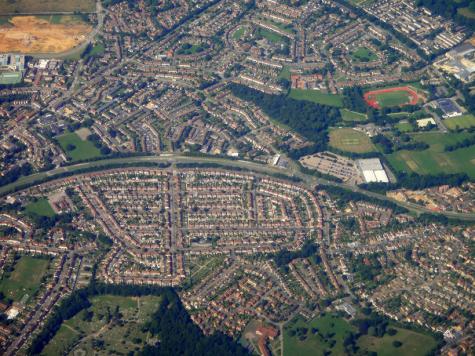What is the North/South divide?
There has long been a belief that there is a divide between the north and south of England. This is based on a number of factors, including employment opportunities, culture and housing. The original demarcation of the north south divide (mythical or actual) was the Watford Gap Service Station, which was the first service station built in the UK to coincide with the opening of the first section of the M1.
The service station was named after the neighbouring village of Watford, in Northamptonshire and it was regarded as a halfway point when travelling north from London. In recent years, however, the far larger town of Watford, situated much further south, in Hertfordshire, has become synonymous with the line of the north south divide, especially for Londoners.
The reasons for this are based on the fact that Watford is the largest town on the northern boundary of the M25 and it is also the furthest point north on the London Underground network; both of these influence the outlook of native Londoners, some of whom regard anything north of the M25 as “northern” England.
How much truth is there in the existence of a North/South divide?
Although the UK economy is picking up after several years of world-wide recession, the growth has been very uneven. A recent article in the New Statesman highlights the fact that employment prospects are far greater in London and the neighbouring Home Counties such as Hertfordshire than in the northern cities, with the exception of Aberdeen and its oil and gas industry.
This would seem to support the view that there is a north/south divide. Another clear difference, almost certainly related to the employment prospects, is that most of the recent increase in activity in the property market and in house prices has taken place in London and the south east, whilst the property market in the north is still fairly static.
The downside of that is that it is more difficult for prospective house buyers to get onto the property ladder in the south, although the government’s recent “Help to Buy” may assist with this, especially for people seeking to move house to towns outside central London. When it comes to culture, however, there have been a number of notable developments in the north of the country such as the Sage at Gateshead and the Tate Gallery in Liverpool, although, obviously, London still has the largest number of theatres, concert halls and art galleries by some distance.
Where does Watford stand?
Watford is the largest town in the northern Home Counties and, whilst having fast and frequent commuter links into central London, it also has a fair number of large employers locally, who have found that being based there is an ideal compromise between being convenient for London without the exorbitantly high costs for office premises in the capital.
Housing is also far more affordable than living closer into the centre, so it is always useful to make contact with a local removals company such as www.aboutthisvan.co.uk, who can help to take the strain out of the process if you decide to move house (or office) to or within the Watford area.
In many ways, Watford has the best of both worlds, as it has excellent transport links, both road and rail, reasonable employment prospects on the doorstep, so avoiding the costs of commuting into London, and quite a thriving social life, with larger numbers of young people and families living there. If you have a preference for moving house somewhere a little quieter, Hertfordshire has many pretty villages such as Kings Langley which is just to the north of Watford.
At the end of the day, it seems possible that some of the “North/South divide” is more in people’s attitudes, with a certain, sometimes marked, preference for London for Londoners and the north for northerners. Perhaps the proposed high speed rail link to Birmingham and further north really will bring greater prosperity; it is a fact of life that people have to work and, without employment prospects in the north, the statistics will continue to show far higher unemployment in the northern cities than in the south.
Featured images:
License: Image author owned
George Gregoriou lives in Watford, so is very familiar with both the town and the neighbouring area. He set up his own light removal company in 2002, using Luton vans, and works mostly in north London and the northern Home Counties, although he will travel further afield. As a father with a young family, he doesn’t have a great deal of spare time at present as he enjoys spending time with his young daughter and is looking forward to teaching her to swim, ride a bike – and play football.
